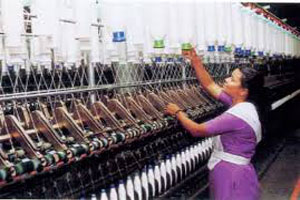
Bangladeshi spinning sector worried over sliding yarn prices
YarnsandFibers News Bureau 2015-10-04 14:00:00 – DhakaThe fall in consumption in China, the largest cotton-using country in the world is likely to affect the Bangladeshi spinning sector in two ways. Firstly, the slide in consumption will lower the prices of raw cotton worldwide further, which will also narrow the profit margins in Bangladesh. Secondly, other countries will break into the local yarn market as they will be able to supply the raw materials at cheaper rates.
Bangladeshi spinners cannot lower the yarn prices any further as they have to purchase cotton at higher prices than the market rate for not having hedging facility and warehousing system in the country. Hedging is a risk management strategy used in limiting or offsetting probability of loss from fluctuations in the prices of commodities, currencies, or securities.
Cotton importers can hardly enjoy the benefits of lower prices in the world market in the absence of hedging facility and warehousing system, according to industry insiders.
Spinners who had bought cotton at higher prices have to sell yarn at low prices now as cotton prices have declined much since then, putting them in a tight corner.
Currently, cotton is trading at 60-62 cents in the international market, with expectations of further decline on account of the substantial old stock, especially in China. New crops too will become available from next month.
According to Razeeb Haider, managing director of Outpace Spinning Mills, if the cotton prices decline further, the yarn prices will also go down in the domestic market. At the same time, cost of production has been increasing in the spinning sub-sector.
The latest hike in the prices of gas and power is another blow to the spinners, said Haider, who is also a director of Bangladesh Textile Mills Association.
Recently, a lot of Indian and Chinese companies have opened offices in Bangladesh for selling yarn to local knitters and weavers. So, they have fierce competition, Haider added.
Moreover, the government said recently that it will not allow installation of captive power generators in spinning mills to save gas consumption. As a result, the spinners will have to purchase power from companies at higher prices.
The government should reduce the price of power for survival of the primary textile sector, said Abdul Hai Sarker, chairman of Purbani Group and a former BTMA president.
The use of multi-blend yarn in the global fashion industry is also responsible for the fall in prices of cotton.
During the volatility in cotton prices in 2010 and 2011, fashion designers switched to other fibres to reduce the price burden.
Moreover, yarn consumption declined in the domestic market as many factories cannot produce in full scale due to implementation of the corrective action plans suggested by two foreign inspection agencies -- Accord and Alliance.
But, Momin Mondol, managing director of Mondol Group, said that the yarn prices are stable now, whose mills consume 1,600 tonnes of yarn a month and exports $250 million worth of garment items a year. They target is to export $300 million worth of garment items this year. The favourable yarn prices will help them achieve the target.
At present, the widely-consumed 30-carded yarn is selling at $2.60-$2.65 per kilogram, down from $3.60-$3.65 per kg a year earlier.
Market Intelligence
Ask for free sample Report

experience
Customer Base
dedicated team
Countries Served Worldwide









